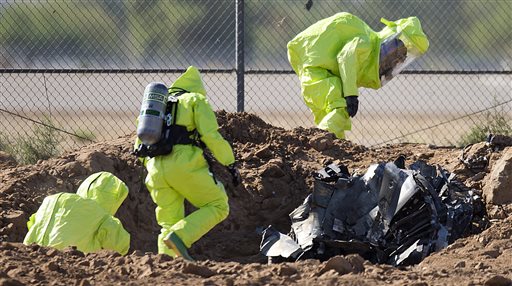By BOB CHRISTIE
Associated Press
GLENDALE, Ariz.
The pilots flying an F-16 fighter jet that went down near Luke Air Force Base in suburban Phoenix reported hitting a bird shortly after takeoff, the Air Force general who commands their base said Thursday.
The two pilots, who were practicing landings and takeoffs at the base Wednesday evening, ejected safely and the fighter crashed in a farm field near the base.
The plane had just taken off when the pilots reported hitting a bird and the engine in the plane malfunctioned, 56th Operations Group commander Col. John Hanna said. They had little time to react.
Base spokeswoman Lt. Candice Dillitte said there’s nothing to indicate a fleet-wide problem with the jets, but the Air Force will investigate the cause. The Air Force has more than 1,000 of the single-engine fighters.
The base, 15 miles west of Phoenix in Glendale, is the world’s largest F-16 pilot training base and had 138 F-16s before Wednesday’s crash. An instructor and a student were flying the jet that crashed.
The base is getting ready to transition to the military’s new F-35 fighter. The Air Force announced Thursday it would receive three additional squadrons, bringing the total to 144 within about 10 years. The first plane is set to arrive next spring.
Witnesses said they heard the jet’s engine sputtering and popping just before the plane went down. Photos posted on Twitter showed civilians helping two male pilots alongside a freshly plowed field.
Rothstein said the fact that the jet came down in farmland wasn’t an accident. Glendale and other nearly cities have worked with the state to maintain open space around the base despite the rapid urbanization of the area.
Any engine problem shortly after takeoff is extremely dangerous and the pilots needed to react quickly, Hanna said.
Bird strikes can severely damage jet engines. US Airways Flight 1549 lost both engines shortly after takeoff from LaGuardia Airport after hitting birds in January 2009 but landed safely on the Hudson River.
An inspector general’s audit last year criticized the Federal Aviation Administration for not doing enough to stop bird strikes. The report cited a five-fold increase in bird strikes over the last two decades, from 1,770 reported in 1990 to 9,840 reported in 2011, due in part to growing bird populations. The strikes have led to at least 24 deaths and 235 injuries in the United States since 1988.

COMMENTS
Please let us know if you're having issues with commenting.